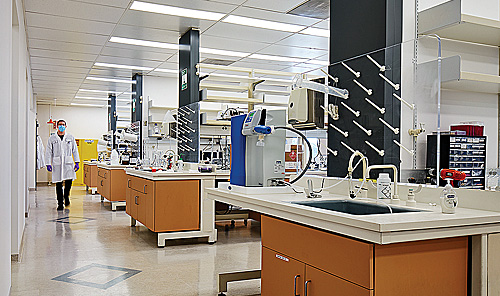Redevelopment of Space for Booming Life Sciences Firms
As life sciences firms look to ramp up production, many are considering redevelopment of sites formerly put to other uses.
Q4 2020

Developers are taking note that some markets that have the assets of a life science cluster — such as proximity to large medical and university campuses and quality-of-life benefits for a growing workforce — haven’t yet actualized into a cluster, and they have an opportunity to seize the moment. Such developers are building new offices and research facilities and converting old structures into labs. Economic development commissions also have the opportunity to partner with developers to help bring the pieces together to draw life sciences companies and create these new clusters.
An Eye to Distinct Requirements
When looking for the right space, life sciences firms should partner with developers, designers, and a construction team that will redevelop the space with an eye to the nuances and distinct requirements of labs, such as ceiling height, mechanical and HVAC systems, and space for lab equipment. Since each type of lab — chemistry, biology, pharmacological, etc. — looks different and requires unique equipment, a first-time lab developer that goes with a one-size-fits-all approach probably won’t appease its lab tenants.
Specific improvements for different lab users could include more fume hoods and sinks for chemical labs; extra room for negative air pressure chambers and changing rooms to keep parasites from escaping the lab for biology researchers; and more specialized temperature and humidity controls to keep samples safe for pharmaceutical scientists.
While redeveloping old space for lab purposes isn’t necessarily cheaper than building new, it can be faster. But labs aren’t the only part of life sciences workspace — researchers spend a surprising amount of time at their desks or in conference rooms. Some developers think that the only focus should be the lab — which is certainly important — but savvy developers know the office space is just as much of a priority for researchers. Life sciences firms should look for development and construction teams that know how to balance lab and office space to bring to life a full workplace.
Choosing the Site
Sourcing the site itself is another challenge — not all existing buildings and spaces convert well to lab space, and some should be passed over all together. For example, chemistry labs can’t be built out in upper floors of a high-rise because they don’t have the vertical access shaft requirements to handle the volume of chemicals. But there are a number of sites that are promising: buildings that were healthcare facilities and former cold storage warehouses often have the infrastructure to be retrofitted into lab spaces, including piping systems, low ceilings, and thick walls.
The need for research has been emphasized by the COVID-19 pandemic, but it’s always been there, and it will only become more essential into the future. And going into expansion mode during a recession isn’t easy. While redeveloping old space for lab purposes isn’t necessarily cheaper than building new, it can be faster — especially when time is of the essence.
Project Announcements
Momentous Expands Summit County, Utah, Operations
12/21/2025
Eli Lilly and Company Plans Huntsville, Alabama, Manufacturing Operations
12/18/2025
BioTouch Expands Columbus, Georgia, Operations
12/11/2025
BioStem Technologies Plans Boca Raton, Florida, Headquarters Operations
12/06/2025
AstraZeneca Expands Frederick-Gaithersburg Maryland, Manufacturing Operations
11/29/2025
South Korean-Based Nature Cell Plans Baltimore City, Maryland, Production Operations
11/19/2025
Most Read
-
The Workforce Bottleneck in America’s Manufacturing Revival
Q4 2025
-
Rethinking Local Governments Through Consolidation and Choice
Q3 2025
-
Lead with Facts, Land the Deal
Q3 2025
-
Investors Seek Shelter in Food-Focused Real Estate
Q3 2025
-
Tariff Shockwaves Hit the Industrial Sector
Q4 2025
-
America’s Aerospace Reboot
Q3 2025
-
The Permit Puzzle and the Path to Groundbreaking
Q3 2025